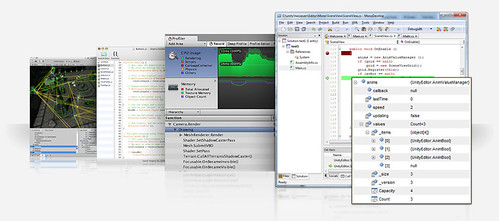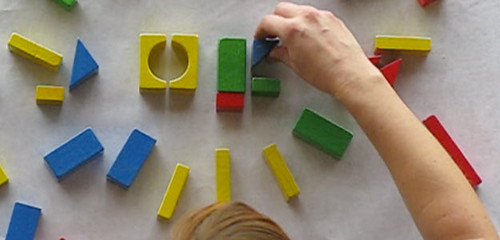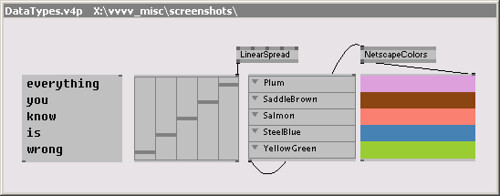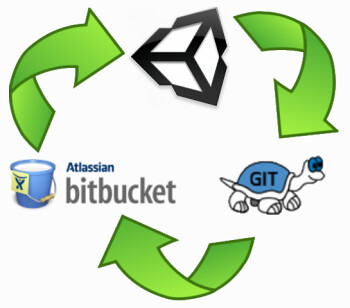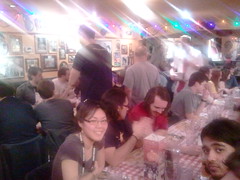Well, ok maybe not quite that dark, but at least I look somewhat civilized when I'm using a Kinect, unlike well...

Gah, ok ok, I promised myself i'd stop talking smack about former large software companies i may or may not have worked for. I dunno it's weird, if you're like me, you always feel like once you leave a company in bad blood, you're forever professionally competing with them as long as you're in the same industry. Not to put too fine a point on anything, or anything, hehe...
Aaaanyway, so i feel like i'm at a good enough spot with KinectCam to drop some knowledge on some folks if you're interested in playing with this stuff yourself. I gotta say I might have written Kinect off a bit early, I'm having a good time playing around with it and its ilk. Granted, none of the games I've ever played on Kinect are doing the sort of stuff I've been doing, I sorta wonder what kind of crazy game you could come up with using the depth stream...Ok, sure, i'm just reaching there, but probably not, I bet someone (Jeff Minter) could come up with some insane depth stream game. Actually I'm thinking of some sort of pattern recog app that i can feed my CD collection into or maybe just stuff the audio array, you know anything to avoid this sort of thing (Hmm, this would be funnier if you didn't have to squint for the text):
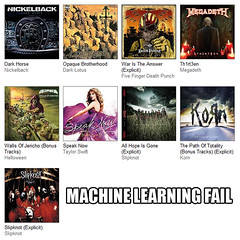
Alright, well, mindless self indulgence aside, let's get to this MS Kinect SDK wrapper. Odd how this will probably be the only such post I make that's going to apply to this particular wrapper, therein crawling another bug up my nose, the fact that I wish MS would just release an official Unity wrapper/plugin/whatever. Truth be told though, it probably wouldn't be terribly hard to compile down my own DLL, it's probably more of a time issue to make sure I expose and marshall everything properly, not to mention proper SDK. But SDK specifics aside, all the maths herein should be pretty easy to re-apply since it's just a few simple space conversion tricks.
So recap from
my previous post, make sure you install the following softwarez:
I've alluded to the camera control thing for a while, so let's just dive right in and get that taken care of, then I'll do a separate post about the Kinect Wrapper guts. Again, that probably won't be terribly interesting, mainly it's just for me.
Alright, so to get stuff working in this environment is pretty simple. Import the
KinectWrapperPackage and you'll have all the scripts and objects you need to get started. I recommend just starting with a blank scene and build up for there, altho you could pop open the KinectExample scene and make blobs dance around wildly.
Once you have a new scene (taxing task that that is), all that's required to make it Kinect-aware is to drag a
Kinect_Prefab from the Project into the scene, as so:
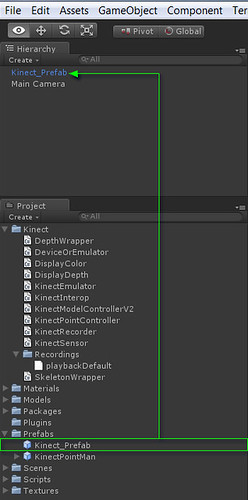
This scene doesn't actually do anything yet, obviously, but you can use the
Kinect_Prefab to setup your camera. If you play the scene, you may notice the camera moving around a bit and focusing in odd places (hey buddy, my eyes are UP HERE), which can be fixed by setting some values in the
KinectSensor attached to the
Kinect_Prefab:
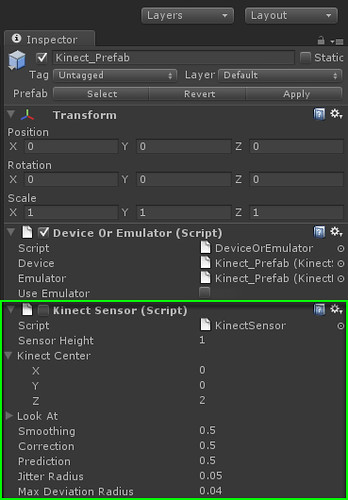
I've been using the included Skeletal Viewer in the SDK to make sure i'm getting good coverage, once you find some numbers that work, you can always go into the
KinectSensor code and set your own defaults if you want.
Alrighty then, time to get the camera moving. So, I went the hack route and used Unity's built-in
MouseLook script as a jumping off point, as it only required a few minor changes to the camera transform code. The part that requires a bit of work is getting Kinect skeletal numbers into Unity friendly numbers, and when i say "bit", i mean it, it's actually not that hard. So the first thing I did was for my own sanity, and that's setup a little GUI indicator that tells me if I'm tracking or not. Polling the camera for the depth image in this wrapper is a bit annoying because you have to restart Unity every time you stop running. Might be a fun project to figure that out and re-implement depth and color display as a GUI texture. Something to keep in mind for my next project. Anyway, so verifying tracking is pretty simple, i put this all in a script called
FromBonePosition:
Pretty straightforward, we're just pulling some functionality from the included
SkeletonWrapper class, which...well, wraps Skeleton functionality. Truth be told, I feel like this class is a bit of an extra, but whatever. Anyway, breaking down the code:
- Really all pollSkeleton() does is call the native NuiSkeletonGetNextFrame(), i'll leave what that probably does as an exercise to the reader.
- trackedPlayers[] is interesting. The details of how we get there are a bit unimportant at this stage, the important note is that we're grabbing an enum that tells us what we're tracking. KinectWrapper initializes the values in trackedPlayers[] to -1 which indicates that we haven't even acquired a skeleton. The possible enums are NUI_SKELETON_NOT_TRACKED, NUI_SKELETON_POSITION_ONLY, and NUI_SKELETON_TRACKED. So if either of the two players is acquired, we can say we've tracked.
- So once we've tracked, we spit out a string to the UI that tells us what's up.
Easy-peasy, yeah? Well fear not, most of the Kinect polling is that straightforward, it's just flipping the numbers that takes some code. So let's continue by polling the Kinect for a bone position, which we'll use to drive our camera. Yeah, yeah, i know, classic Kinect "Hello, World!", recreate a mouse driver, but it's an easy place to start.
Joints are pretty easy to poll, as the
SkeletonWrapper class provides a few different arrays that contain joint information and the SDK provides us a convenient enum for specifying which joint to query for data. So let's add some code to our class:
Simple, efficient (like the body itself), we add a variable to hold the right hand's position, then we pull a value from the
bonePos[] array on the
SkeletonWrapper. You'll notice
bonePos[] is a 2D array, the first id is which skeleton to poll (we might be tracking two players), the second id is pretty obviously the joint we want to get the position for. You can see the full enum definition in the
KinectInterop class if you should ever want to poll a different joint, or if you want to update a bunch of joints, or a whole skeleton, or make tea, or something like that. We output that number to the GUI too, a) for verification purposes and b) so we can set some other numbers later.
By now we pretty much know all the kinect stuff we need to know to get our camera moving, so let's get our camera look on. Here's our member list (with comments!):
And now...Maths! The basic theory behind what we're doing is pretty simple:
- Find the distance (as a percent) between the minimum and maximum x (oldX) that we get from the Kinect
- Repeat for y
- Cast that into (-1,1) so it mimics Unity's mouse input values
- Rotate the camera
- Profit, or at least impress your friends (or your mom)
This is pretty simple, we can use some of the Unity built-ins to do all the scary maths for us, i'll just post the relevant code here:
So yeah, we're basically parroting
MouseLook's rotation setting and replacing
Input.GetAxis() with the data we poll from the Kinect. This SHOULD work, as it's almost verbatim the code I was using minus things like aim assist and project specific passing. Play around with the
OldX and
OldY values, the Kinect SDK says that values for X can lie between (-2.2, 2.2) and Y can be (-1.6,1.6), but that's going to vary a bit depending on where you're hanging out. For example, the values we ended up using were OldX = (-0.3,0.7) and OldY = (1.3,2.4). Drop a texture onto the gui and set the rectangle based on hand position, that's a pretty simple way to get some good debug. It's not too tricky to cast your value into screen space, try it out!
I think that's all I got for now, going to try and port this to OpenNI/PrimeSense just for fun this weekend too.


